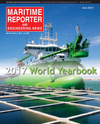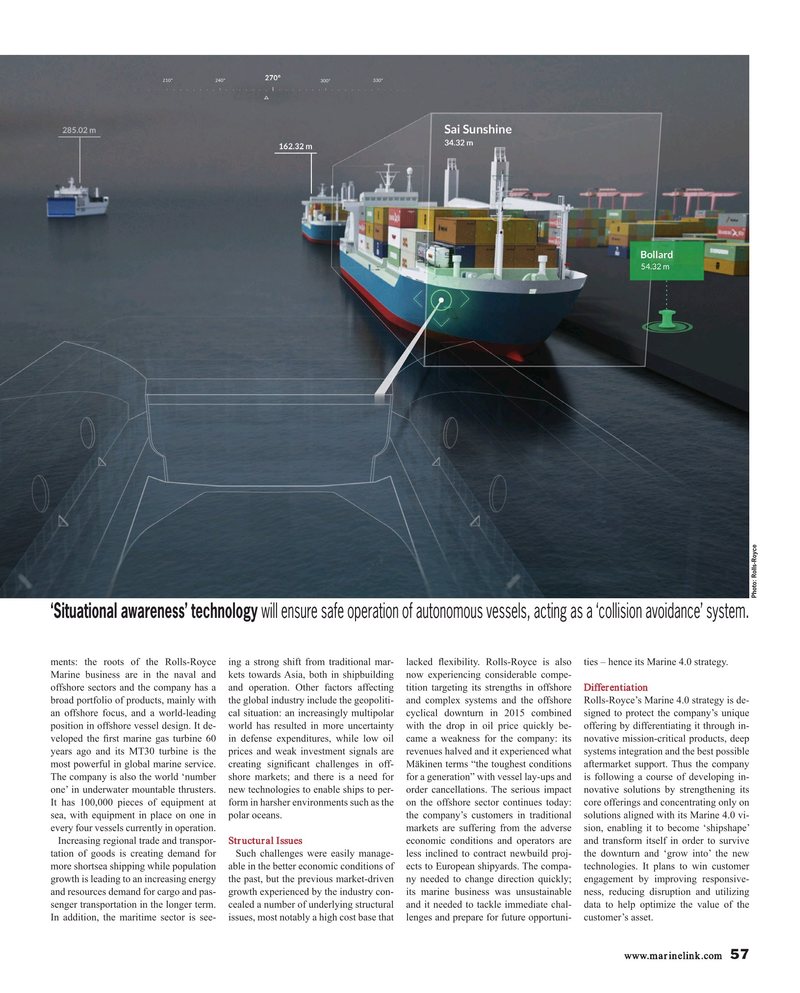
Page 57: of Maritime Reporter Magazine (June 2017)
U.S. Navy Quarterly
Read this page in Pdf, Flash or Html5 edition of June 2017 Maritime Reporter Magazine
Photo: Rolls-Royce ‘Situational awareness’ technology will ensure safe operation of autonomous vessels, acting as a ‘collision avoidance’ system. ments: the roots of the Rolls-Royce ing a strong shift from traditional mar- lacked ? exibility. Rolls-Royce is also ties – hence its Marine 4.0 strategy.
Marine business are in the naval and kets towards Asia, both in shipbuilding now experiencing considerable compe- offshore sectors and the company has a and operation. Other factors affecting tition targeting its strengths in offshore Differentiation broad portfolio of products, mainly with the global industry include the geopoliti- and complex systems and the offshore Rolls-Royce’s Marine 4.0 strategy is de- an offshore focus, and a world-leading cal situation: an increasingly multipolar cyclical downturn in 2015 combined signed to protect the company’s unique position in offshore vessel design. It de- world has resulted in more uncertainty with the drop in oil price quickly be- offering by differentiating it through in- veloped the ? rst marine gas turbine 60 in defense expenditures, while low oil came a weakness for the company: its novative mission-critical products, deep years ago and its MT30 turbine is the prices and weak investment signals are revenues halved and it experienced what systems integration and the best possible most powerful in global marine service. creating signi? cant challenges in off- Mäkinen terms “the toughest conditions aftermarket support. Thus the company
The company is also the world ‘number shore markets; and there is a need for for a generation” with vessel lay-ups and is following a course of developing in- one’ in underwater mountable thrusters. new technologies to enable ships to per- order cancellations. The serious impact novative solutions by strengthening its
It has 100,000 pieces of equipment at form in harsher environments such as the on the offshore sector continues today: core offerings and concentrating only on sea, with equipment in place on one in polar oceans. the company’s customers in traditional solutions aligned with its Marine 4.0 vi- every four vessels currently in operation. markets are suffering from the adverse sion, enabling it to become ‘shipshape’
Increasing regional trade and transpor- Structural Issues economic conditions and operators are and transform itself in order to survive tation of goods is creating demand for Such challenges were easily manage- less inclined to contract newbuild proj- the downturn and ‘grow into’ the new more shortsea shipping while population able in the better economic conditions of ects to European shipyards. The compa- technologies. It plans to win customer growth is leading to an increasing energy the past, but the previous market-driven ny needed to change direction quickly; engagement by improving responsive- and resources demand for cargo and pas- growth experienced by the industry con- its marine business was unsustainable ness, reducing disruption and utilizing senger transportation in the longer term. cealed a number of underlying structural and it needed to tackle immediate chal- data to help optimize the value of the
In addition, the maritime sector is see- issues, most notably a high cost base that lenges and prepare for future opportuni- customer’s asset.
www.marinelink.com 57
MR #6 (50-57).indd 57 MR #6 (50-57).indd 57 6/9/2017 9:10:51 AM6/9/2017 9:10:51 AM

 56
56

 58
58
